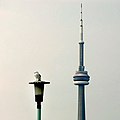
A visual pun is a pun involving an image or images (in addition to or instead of language), often based on a rebus.
Visual puns in which the image is at odds with the inscription are common in cartoons such as Lost Consonants or The Far Side as well as in Dutch gable stones. For instance, a gable stone in the village of Batenburg puns on the words baten (‘to profit’) and burg (‘castle’) by depicting silver coins becoming gold in a castle.
European heraldry contains the technique of canting arms, which can be considered punning.
In heraldry[edit]
Visual puns on the bearer's name are used extensively as forms of heraldic expression, they are called canting arms. They have been used for centuries across Europe and have even been used recently by members of the British royal family, such as on the arms of Queen Elizabeth, the Queen Mother and of Princess Beatrice of York. The arms of US Presidents Theodore Roosevelt and Dwight D. Eisenhower are also canting.
In visual arts[edit]
Surrealist artists such as Salvador Dalí, René Magritte, Marcel Duchamp, and Remedios Varo made extensive use of visual puns, as they played with shifting perceptions and reality. Graphic artists (such as Maurits Cornelis Escher and Noma Bar) and photographers (such as Man Ray and Dora Maar) have used visual puns for a surreal or humorous effect, or to catch the attention of a viewer. Some types of optical illusions also operate within the liminal zones of perception.
Gallery[edit]
-
USAF squadron emblem shows a kicking donkey (ass) with slogan "Kickin' Ass"
-
All is Vanity (1892) by C. Allan Gilbert (the table is a vanity)
-
Royal standard of Queen Elizabeth, the Queen Mother (a canting arms), her maiden name being Bowes-Lyon: bows and lions.
-
A lamppost (foreground) and Toronto's CN Tower (in distance)
-
Washington crossing the Delaware
See also[edit]
Further reading[edit]
- Christian Hempelmann and Andrea C. Samson. “Visual Puns and Verbal Puns: Descriptive Analogy or False Analogy?” In: Diana Popa and Salvatore Attardo (Eds.), “New Approaches to the Linguistics of Humor.” Galati: Dunarea de Jos. 2007. 180-196.
- Heller, Steven (12 April 2012). "The Object Poster, the Visual Pun, and 3 Other Ideas That Changed Design". The Atlantic. Retrieved 10 March 2018.
- Shnidman, Ronen (8 February 2012). "Dror Karta's Play With Visual Pun". Algemeiner Journal. Retrieved 10 March 2018.
- Mendoza, Manuel (28 January 2017). "Bridgman|Packer creates visual puns, evokes sensuous mystery by blending dance with video imagery". Dallas News. Retrieved 10 March 2018.
- Mufson, Beckett (21 December 2015). "Korean Artist Makes Visual Puns from Pop Culture | Monday Insta Illustrator". Creators. Vice Media LLC. Retrieved 10 March 2018.
- Wilson, P.F. (25 January 2016). "Can you guess Matthew Broussard's visual puns?". City Pages. Retrieved 10 March 2018.
- Boyd, Chris (18 January 2018). "La Vie Dans Une Marionette: visual puns, no strings attached". The Australian. Retrieved 10 March 2018.
- Abed, Farough (March 1994). "Visual Puns as Interactive Illustrations: Their Effects on Recognition Memory". Metaphor and Symbolic Activity. 9 (1): 45–60. doi:10.1207/s15327868ms0901_3.
References[edit]






